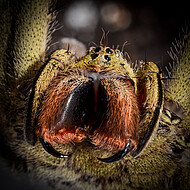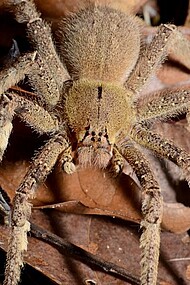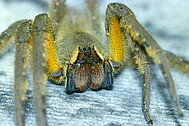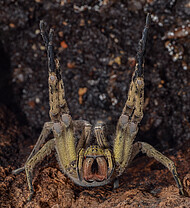Phoneutria - introduction
Phoneutria has probably the worst reputation among the araneomorph spiders. In almost every published text, even in some non-fiction books covering this subject, they are described as "extremely dangerous", "extremely aggressive" and "(most-) toxic", "highly venomous", or just "deadly". There are also dozens of "true" field reports giving the impression that these spiders must be the pure evil. But this is actually just half the truth.
Talking about Phoneutria, we have to be aware that there are now (2021) nine (valid) species, with different genetics, geographic distribution, habitat preferences, biology and natural history traits and that information we find just under “Phoneutria” is indiscriminately generalized (undifferentiated) information and might not be true for all the species in the genus. Recently Hazzi & Hormiga (2021) revealed that most studies on P. boliviensis actually refer to the revalidated sister species P. depilata.
Why are Phoneutria spiders so impressive?
Most Phoneutria species are quite large, and as a matter of fact the genus comprises the largest known araneomorph spiders. With a total body length of about 5 cm and a leg span of about 18 cm, some Phoneutria species earn the record of world's largest true spider, at least regarding body weight and body size (some sparassids and some Ancylometes have a greater leg span).
Phoneutria species show a distinctive defence behaviour (full thread display, see picture below), when they feel threatened. This behaviour is a "back-off"-signal that (if being ignored) will sooner or later lead to a biting attempt of the spider.
However, it should be emphasised here, that this behaviour is primarily defensive, although often mistaken for aggression. In rational terms, Phoneutria spiders only do the same as many other animals: They try to defend themselves when being threatened. At most some have a very low threshold to feel disturbed or threatened.
Important is that the spiders do not (attempt to) bite people by chance. Rather the opposite - from a spider's perspective it is quite costly to "waste" venom on humans. It takes time and energy to produce the venom which primarily serves to immobilize and eventually kill the prey and a spider that spent its venom on uneatable things may be unable to overcome prey soon after and may therefore have to hunger for a while. So, a spider should only be "willing" to give a "full bite", with venom injection, when it really feels threatened, like when it seems to be a matter of life and death (from the spider's perspective). And this is how biting accidents happen: People unaware of the spider's presence, make movements towards the spider, or even get a hold of them accidently, while e.g. sorting bananas. The nocturnal spider that seconds before was sitting in a banana stalk, hiding from the daylight, now finds itself in a stressful situation, threatened to be crushed/killed by the five-fingered predator that is now having the spider in its grip. The natural response of the spider to such a situation is a bite.
There is no doubt that the venom of some of the species is quite potent for mammals, including humans. Since there is not much information available about the evolution of these spiders, e.g. what triggered their defensiveness or their venom composition, we have to keep in mind that it may be a result of co-evolution of prey-predator interactions. Due to their size and the abundance of small amphibians, reptiles and mammals in their tropical environment it might have been an evolutionary advantage to have venom components effective on vertebrates. In combination with colour signals and defence behaviour (typical alarming of Phoneutria), an effect of the venom on mammals was maybe evolutionarily “requested”. In fact there are mammalian predators of large wandering spiders, not us, but the coatis (Procyonidae - raccoons) and other small insectivore mammals. Hence, our “sensitivity” to the spider’s venom is probably just a coincidence (read more under toxicity).





